|
|
Post by antoniofp45 on Jul 25, 2012 21:55:12 GMT -8
Hi everyone, In advance, please forgive some of the blurry photos. The subject here is is an HO GMC Transit "Fishbowl" bus from Busch. Second one I purchased from Happy Hobo Trains a few years ago (Thanks Kevin, I miss ya). I've always been a big fan of these buses as I liked that body design! They were always a part of my childhood and youth years. As a kid, I often rode the prototypes with my mother in NY. As a young adult in Florida, I worked on them at a transit authority. Built factory tough with many racking up millions of miles. Anybody remember the movie "Speed"? Busch did a nice job on these and for the price they're hard to beat. There are 3 issues that I have with them; two of which are easy to fix. 1. The dull silver finish of the corrugated "aluminum" sheet metal is unrealistic. 2. The painted-on red tail lights. 3. The Condenser Fan Motor cover (roof spoiler) is about 4" too narrow. Instead of completely redoing the coach, I decided to try the "Work with what you got approach" on this unit and freshen it up a bit without spending a lot of time on it. It's not finished yet, as it needs additional lenses and more weathering (and mirrors; Grrrr!). Like my first unit, I wanted to alter the color scheme to a freelanced version that's in my head.
BTW: I don't know how or where I put them but I can't find the mirrors for both of the buses, lol!  I have many storage trays but I likely stored them in the wrong one. I'll probably find them when I'm not looking for them.  Here is the bus in stock form and a photo of a prototype: 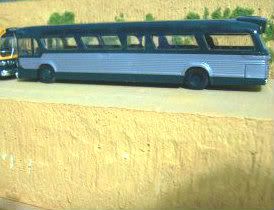 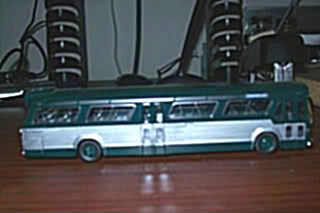 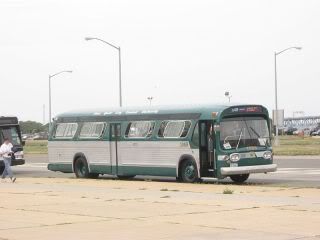 For those wondering, here's an easy guide that shows with photos how to take apart one of these buses. www.barp.ca/bus/models/buschdisassemble/index.htmlOne thing, though. Instead of a knife to remove the bottom, use a slim flat blade screwdriver. The bottom pops off with minimal effort. After disassembly, I painted the bottom skirt panel a custom mix of Polly Scale CSX yellow and SCL Caboose Orange, allowed it to cure, then masked it off. I also took the tires off, and simply wet-coated the wheels with the paint mix. I wanted to the stock green to show through to give the effect of some grime and paint chipping on the wheels. Next, I slowly drilled out the tailight lenses starting with slim drill bits and finishing with larger diameter bits. I would never recommend a Dremel for this. The Pin Vise is much easier to control: 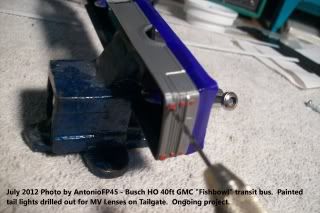 After cleaning out the residue from the lens housings, I carefully wiped off the wall section with isopropyl alcohol several times on a dampened cloth. Next I airbrushed 2 very thin wet coats of medium gloss gray and allowed to cure. Followed up with thin mist coats of Alclad #ALC 119 Airframe Aluminum. 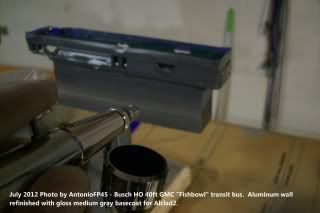 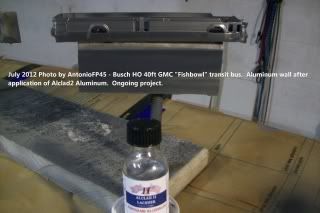  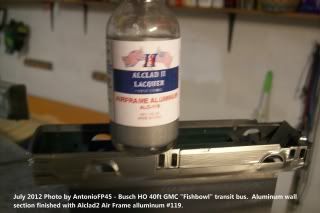 Next, I put the now-Alcladded lower section back in the vise in a vertical position (good idea to apply cloth or masking tape on the jaws of the vise). I next applied "Zap-a-Gap" gel CA adhesive inside of each tail light /brake light housings with a tooth pick. Then carefully picked up each lens and installed. The gel adhesive allowed me enough time to move the MV Lenses around into position. For me, this was the most tedious part of this process. 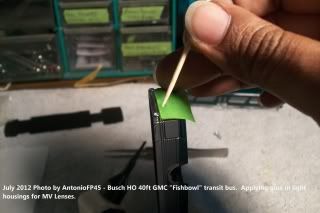 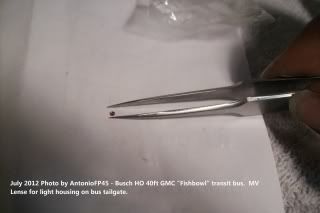 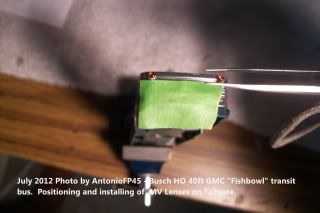 Interior InteriorI remember well that odd aquamarine-green that the NYC Transit authority had in many of their fishbowl buses. Although I'm not modeling the NYC TA I still wanted to capture that basic appearance. I made a mixture of Polly Scale NYC Jade Green 70% with Polly Scale Penn Central Green 30%. To imitate the semi-polished steel grab rails mounted on the seats, I painted the top section Polly Scale Santa Fe Silver.  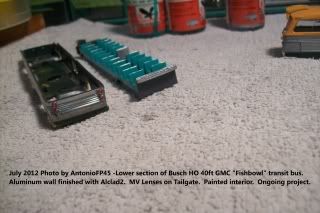 Bumpers: Bumpers: Note: Yellow top bus has factory silver on the lower section & tailgate. Green topped bus has the Alclad2 on the lower section & tailgate (lightly weathered). 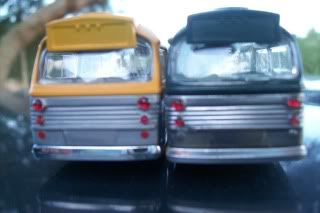  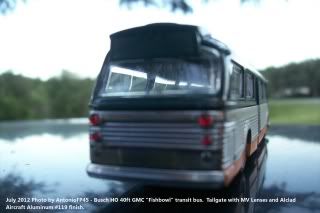 I applied thin coats of clear on the rear bumper of this bus to dull it down a bit while I refinished the front bumper to a duller appearance. From my experience the front bumper dulls more quickly, while the rear bumpers (inspite of the heat from the engine) seem to keep their reflectivity longer (although in New York they were often banged up from tailgaters.....just like today's buses! I reassembled the unit and took a few shots, including some of my first Busch bus. Notice the stock silver finish of the Yellow fishbowl compared to the unit with the Alclad finish. Both buses have MV Lenses on the rear. I ran out of MV Lenses so I could not do the bottom lights. 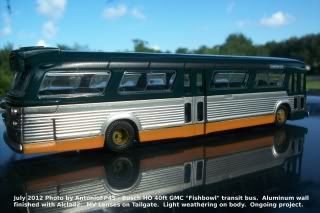 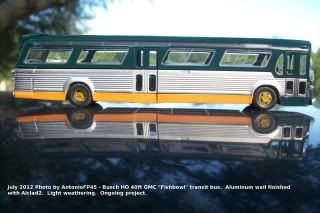 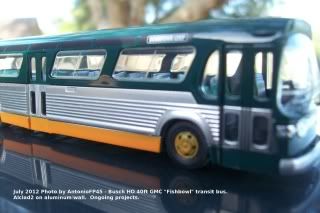 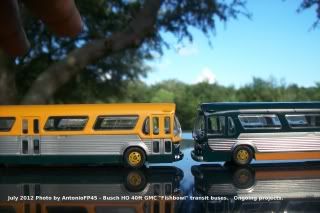 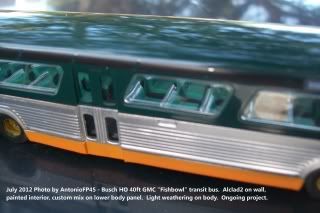 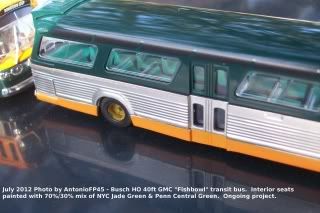  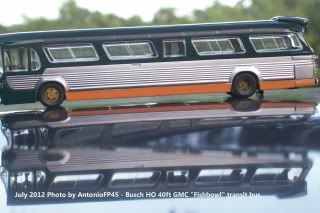 Here are a few shots with the Condenser Fan Motor Cover (spoiler) removed as it lifts off easily. Many prototype units originally came in this version, with the motor mounted underneath the coach. If you want to model that version, fill in the hole with styrene and body putty. Primer, then paint to match. I plan on purchasing another unit and doing it in that version. 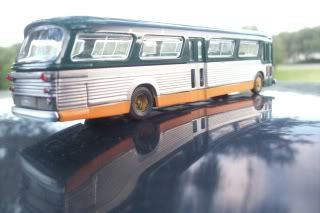 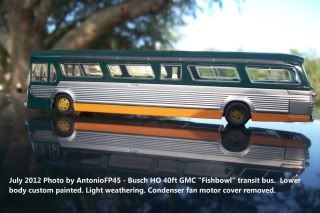 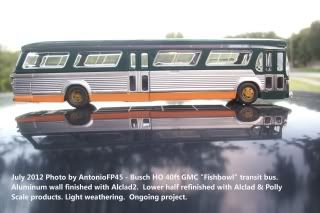 Quick Notes: A. The MV Lenses I used were slightly oversized. For the brake lights (large) use MV LS-281 instead of LS-200, which is what I used. For the smaller lights MV #220 works nicely. B. You can alter the Aluminum's appearance (lighter, darker) with the basecoat, just as with passenger rail cars. I hope that this thread is helpful. I still have a ways to go in finishing both of these buses but imho, a little "sprucing up" like this can really make one of these classic transit workhorse stand out in a city or town scene.  |
|
|
|
Post by antoniofp45 on Jul 26, 2012 6:48:08 GMT -8
Replying to a question regarding window tinting and other details on GMC fishbowls. I plan on tinting the side passenger windows and adding other details once I finish metalizing the my Budd and PS cars and those of a friend. I'll apply either Alclad's "Black Smoke" or the green "Armoured Glass". 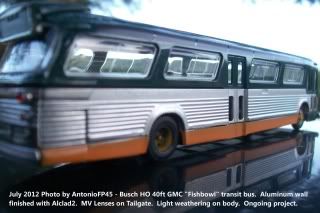 From my cobweb laden memory, the fishbowls could be ordered with no tint, a very light "smoked" tint, or green tint. The units I worked on had a smoke gray tint, but the replacement glasses in our parts dept had a light green tint. The windshied was in six pieces. The top two were sometimes tinted, depending on the owner. The large 2 glasses in the middle and the lower 2 glasses were untinted as was the large back window. Remember that these buses were produced from 1959 thru the mid 1970s. I salute the Canadians in their GMDD plant for continuing to build them thru the 1980s. The interior/exterior/ options varied greatly in style and color over the years. There are loads of photos available on the internet for references. --------------------------------------------------------- On a personal note, from the late 1980s-early 90s my transit system's managers were retiring our remaining fishbowls and Flxible New Look buses. Some of them sold for as little as $1500 with spare parts included at the public auction! My boss, knowing I was a bus fan, asked me if I wanted one but I passed on it. They had many miles on them, of course, and were generally in decent shape. I regret now not getting one as I did have space for one at my first house (tiny house, big yard). They're collector's items now. At that time, it was considered "cool" to be a classic car fan or a hot rodder, and I owned a performance car. But the attitude from some of my coworkers and friends regarding my being a bus fan was basically "Come on Tony, what do you want to do with a bus? Just get a Camaro or an RX7!" (funny as I already owned a hopped up Firebird, and later a Trans Am) Yet, years later, I found out that there were many bus collectors all over North America that enjoyed restoring and running these pieces of American history just for the fun of it. Lesson learned. |
|
|
|
Post by calzephyr on Jul 26, 2012 8:44:30 GMT -8
Antonio
Nice use of the Alclad and please post some more pictures when the windows are tinted!
Larry
|
|
|
|
Post by antoniofp45 on Jul 26, 2012 15:49:19 GMT -8
Thanks Larry, I'm actually in an indecisive pickle as so many of the 1960s era Fishbowls had untinted windows, but in later years many did. ----------------------------- BTW guys, Was going over a bit with a skeptical modeler regarding the bright seat color of the NYC fishbowls back in those days. What was GM and NY MTA thinking, LOL  ? Well, it was the 1960s-70s and "loud colors" were in. A picture shows it better: Photo by David DePrimo: 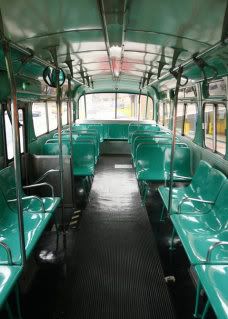  I'm not exact, but was trying to get "reasonably close" lol. In one of my books, a photo is shown of a Penn Central Metroliner club car interior with bright orange seats for business travelers! |
|
|
|
Post by rhpd42002 on Jul 26, 2012 17:18:07 GMT -8
Wow, Antonio, even more nice work.
Great tutorial, too.
|
|
Deleted
Deleted Member
Posts: 0
|
Post by Deleted on Jul 26, 2012 18:42:35 GMT -8
|
|
Deleted
Deleted Member
Posts: 0
|
Post by Deleted on Jul 26, 2012 18:46:44 GMT -8
|
|
|
|
Post by buffalobill on Jul 26, 2012 18:49:16 GMT -8
Very nice work Antonio, these units were around for a long time the 1960's through the 1980's. I used to ride them every day to High School.
Bill
|
|
|
|
Post by bdhicks on Jul 26, 2012 21:44:38 GMT -8
Looking good
|
|
|
|
Post by Judge Doom on Jul 26, 2012 23:39:42 GMT -8
Very nice job reworking those! Those and the larger Corgi models are quite nice, although more variations (35', 30') would be great as there were many during 1959-1986 fishbowl production. The Toronto Transit Commission up here in Canada was still running a large fleet of rebuilt 1980's fishbowls in everyday service up until late last year. About 52 of those later got refurbished/repainted in 2008 to squeeze yet a few more years from them, the last ones were almost 30 years old when they retired (the average American transit agency replaces buses after 12, sometimes 18 years): cptdb.ca/wiki/index.php?title=File:Toronto_Transit_Commission_2855-a.jpg |
|
|
|
Post by kentuckysouthernrwy on Jul 27, 2012 5:13:29 GMT -8
Nice bus. I rode on that model of bus many times on the Michigan State University campus in the late 60s as they were replacing the older GM transit buses.
|
|
|
|
Post by antoniofp45 on Jul 27, 2012 13:59:40 GMT -8
Thanks very much, guys. It was fun doing this and dosen't take long. The intent here was to show that these classic buses from Busch can be quickly updated, appearance-wise, without a lot of fuss (although I admit that positioning and installing those MV Lenses was a challenge for me). But it's not finished as it still needs more weathering, decals, amber MV lenses on the front roof, red MV lenses on the grill of the spoiler, etc. --------------------------- Now, regarding the condenser fan motor cover. I realize that this may seem very trivial but it bugs me that it's noticeably (to me) too narrow. Look at the comparison photos below of the model & prototype: LOL, to me the spoiler on the model looks more like the back of the bus has a mohawk haircut!  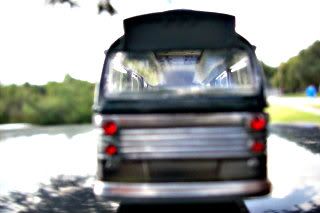 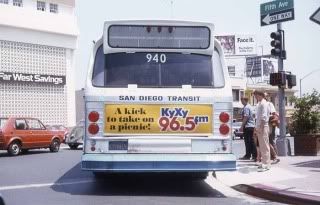  BTW: In transit mechanics lingo the rear engine door or hatch is often referred to as a "tail gate" and the condenser fan motor cover on the classic buses a "spoiler" or wing. None of these terms are actually correct, but in a transit shop simplified terms makes it easy for office workers and/or the brass to understand what the technicians are talking about when referring to frequently used bus parts. |
|
|
|
Post by antoniofp45 on Jul 27, 2012 19:26:49 GMT -8
Jim, I've looked at some of the paint schemes used by Chicago back in the day. Like the other transit systems, I thought the varieties and styles of paint schemes were really neat and creative. No offense to modern bus modelers, but it seems that a good number of today's U.S transit paint schemes are quite bland and the advertising wraps are often the norm. For me as I look at the 1970s-80s paint schemes used on the GM "Salad Bowls" (old look), GM "Fishbowls" (new look), and Flxible newlooks.....I admire the creativity that went into them as well as the great variety. Just "Googling" GMC Fishbowl Transit bus in the images category brings up a lot of nice photos of the variety. Makes it so easy for modelers to instantly create freelance paint schemes for their bus models. RE: Trolley buses. Those are some neat creatures. Cool thing is that some GM salad and fishbowls were used as trolley units as well. Check this one out: www.flickr.com/photos/manofyorkshire/6086589688/  |
|
Deleted
Deleted Member
Posts: 0
|
Post by Deleted on Jul 28, 2012 4:02:43 GMT -8
Thanks for the link to the GMC fishbowl trolley bus!  I lived in the Chicago area for many years and worked and went to college in downtown Chicago and the surrounding area for over 25 years. The GMC fishbowl bus was what made up the Chicago Transit Authority's bus fleet. Most suburban bus companies also used the GMC bus. I never saw the interior of a CTA fishbowl when they first hit the streets of Chicago. Folks in Chicago used to refer to the GMC fishbowls as the "Green Limousine".  What I remember most about the GMC buses was as they got older, the air conditioning began to fail at an alarming rate. I also seem to remember that the CTA's buses had non-opening windows which only made the problem worse. During one hot summer, it was front page news about the CTA's "sauna's on wheels". The CTA said the buses were worn out and installed opening windows. Many of the fishbowls did get re-built by the CTA. If memory serves me correctly that is when the buses got rubber bumpers in place of the steel. The CTA made a half heart effort during the rebuild to "fix" the air conditioning, but mostly abandoned the equipment in place. When I was a student at the University of Illinois at Chicago, I road a fishbowl operated by a suburban bus company from my town to and from downtown Chicago. What I remember the most about those buses were that: A. When it rained water would pour through the windows. So you never wanted to be seated next to a window when it rained....  B. At 55 mph down the Dan Ryan Expressway, the ride wasn't bad, but it wasn't too quiet either. You quickly learned why people would drive a few miles to catch the Illinois Central Electric commuter MU's instead of a short walk and a bus ride. My only advice for your bus model Antonio is it needs ADVERTISING on its sides, front and back. Without ads on the the sides your bus looks.......NAKED  |
|
|
|
Post by antoniofp45 on Jul 28, 2012 19:58:39 GMT -8
OK Jim, I see your point. I've been lookng at a lot of photos and you're correct, so many transit buses in the 70s had advertising on them in a variety of sizes and full range of colors. Most of them were held by rectangular aluminum frames. But, interestingly, during the 1960s it was the opposite situation with the majority of transit buses being bare. You reminded me of something as I remember now that during the 70s large cities, especially NY, were effected by the economic downturn ( I remember my Dad being a bit concerned for his job ) . Transit companies went "ga-ga" in offering ad space inside and outside of buses, in subway stations, and on subway train interiors to make up for the revenue shortfall. It was sometime in 1970 or 71 when I first saw the lighted "Batwings" on the NY fishbowls. I remember thinking how weird they looked and didn't understand then why they were there. forum.bustalk.info/viewtopic.php?p=16820&sid=059a5792b7a1bbe8b6cecb52caa7bdf2 I was glad to see those boards disappear by the 1980s! I'm planning on buying two more HO Fishbowls and, as a "modeling compromise" with selective compression in mind, I'll decorate two of them with ads. One of them will be "grimed up" considerably. ----------------------------------------- Regarding the leaks you encountered: I know that had to be so annoying for passengers, but I think it's understandable why that was problematic in Chicago. Again, during the early 1970s economic downturn coupled with inflation, major budget shortfalls in municipal agencies often resulted. Transit bus, subway, and commuter rail systems in large U.S cities were frequently burdened with "Deferred Maintenance". That was a very disliked term with the public! I still remember NY Subway trains with doors half opening, buses with rattling suspensions, loose body panels, and frequent mechanical breakdowns. On average, the public blamed mechanics and "old equipment". In reality a major factor was that the bloated complacent-minded bueracracies that had been forewarned of upcoming budget shortfalls long in advance, took little action to prevent the inevitable. Strategic marketing was of higher priority than leak repairs, replacing cracked glass, sealing leaks, and rebuilding air condioning systems. Yet we managed to survive that "Penn Central" period which, for me as a kid, still had its simple joys. |
|
Deleted
Deleted Member
Posts: 0
|
Post by Deleted on Jul 29, 2012 4:27:02 GMT -8
Hey Antonio, I know you're down in Florida, but thought you'd like to see the paint on this GMC Fishbowl. gallery.bustalk.info/displayimage.php?album=524&pos=4Doesn't it look like it should be in Miami? The owner was Suburban Transit System based out of Oak Lawn, Illinois. Oak Lawn borders Chicago on the City's southwest side. Another Suburban Transit bus photo. gallery.bustalk.info/displayimage.php?album=524&pos=3By the 1970's Suburban Transit was bankrupt like all the suburban Chicago bus companies. In the mid-1970's with the formation of the Regional Transportation Authority, the company was taken over by RTA and the buses repainted into RTA's colors. Some of the GMC's did survive long enough to get painted in PACE color. PACE is RTA's suburban bus service wing, like Metra is to railroads. |
|
|
|
Post by antoniofp45 on Jul 30, 2012 5:34:38 GMT -8
Jim, Thanks for sharing those links. That's one of the facets that I enjoy about modeling the 60s-70s period: the large variety of color schemes used by transit systems and the railroads as well. I have relatives in Miami and would visit them with my parents in the 70s. I remember that huge bus fleet and liked the orange and white paint schemes that, metaphorically, emphasized Florida's slogan as "The Sunshine State". By the late 1970s, the early model Fishbowls were retired with some in rough shape. Check these out: www.miamidadetransit.com/300series.htmlwww.miamidadetransit.com/gablespage.html (notice the modular rubber bumpers mounted on the bumper plate. Odd looking, but effective. ) I may be mistaken, but I think some of the later model fishbowls soldiered on into the 80s before decommissioning. I disliked the white, blue, and green scheme that they eventually switched to. It was high up on my "Yuck" category. |
|
Deleted
Deleted Member
Posts: 0
|
Post by Deleted on Jul 30, 2012 10:04:29 GMT -8
Antonio:
Did you notice the paint on the Fishbowl used as a training bus in the first link? Those colors look a lot like the NFL Miami Dolphin colors unless the photo's colors are shifted. Now that is something neat.
In Chicago, the CTA began converting a few of the retired Fishbowls to maintenance service. They converted them to shops for crews working on the elevated. Many had their windows plated over, engines removed and tow bars mounted on the front for towing to a location. Kind of sad to see those buses reduced to rolling shops.
|
|
|
|
Post by antoniofp45 on Aug 5, 2012 18:52:15 GMT -8
Hey guys, LOL,  A mental "Vapor Lock" moment for me as I had forgotten that I have an O-Scale Fishbowl (by Corgi) that I purchased about 12 years ago! It's a commuter bus (note that it has no exit door in the middle). It sits in the living room as a decorative piece along with my wife's "knick-knacks". Apparently I've gotten so used this bus that I tend to ignore it. 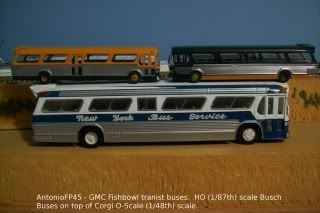 Now, a Corgi O-scale bus would be an interesting vehicle to refinish with Alclad and MV Lenses!  I'm seriously considering adding this unit to my long term list. I'd like to redo it in the NYC MTA 2-tone blue scheme (early 1970s) which, imho, is very attractive. |
|
|
|
Post by rhpd42002 on Aug 6, 2012 7:47:48 GMT -8
Hey guys, LOL,  A mental "Vapor Lock" moment for me as I had forgotten that I have an O-Scale Fishbowl (by Corgi) that I purchased about 12 years ago! It's a commuter bus (note that it has no exit door in the middle). It sits in the living room as a decorative piece along with my wife's "knick-knacks". Apparently I've gotten so used this bus that I tend to ignore it.  Now, a Corgi O-scale bus would be an interesting vehicle to refinish with Alclad and MV Lenses!  I'm seriously considering adding this unit to my long term list. I'd like to redo it in the NYC MTA 2-tone blue scheme (early 1970s) which, imho, is very attractive. SOOOOOO.......... It was "hiding" in plain sight, 'eh!!  Looks like it would be an excellent candidate for your project list. If you decide to do it, keep us posted with progress pics. Nice work all around, Antonio. |
|
|
|
Post by antoniofp45 on Aug 8, 2012 20:30:33 GMT -8
You could say that I had a big "Dunce cap" moment. My current frustration is that MV Lenses in my area are hard to locate.
|
|
|
|
Post by antoniofp45 on Dec 16, 2012 15:43:00 GMT -8
Jim, guys,
I might as well ask this question here instead of starting a new thead.
There are some good signs available online but is it a smart move to just print them on the standard 8 1/2" x 11" copy paper, laminate them, and then apply a flat clear? Or should I look at a more durable material?
Since there are many choices available, which I'd appreciate recommended input from modelers that have already downloaded and printed signs for their scale businesses, train stations, etc.
Thanks for the link to the GMC fishbowl trolley bus!  My only advice for your bus model Antonio is it needs ADVERTISING on its sides, front and back. Without ads on the the sides your bus looks.......NAKED 
|
|
|
|
Post by Christian on Dec 16, 2012 18:00:58 GMT -8
Since there are many choices available, which I'd appreciate recommended input from modelers that have already downloaded and printed signs for their scale businesses, train stations, etc. [/size] I use either matte or gloss photo paper. Laminated to styrene if necessary. The color and sharpness is a dramatic improvement over copy paper. Some brands of photo paper have a resin coating on the back that doesn't like common adhesives. CA or epoxy might be necessary. I use Canon brand and have no issues. Photo paper should be same brand as your printer. As usual, prepare to do some testing and you may find a grocery store brand that works perfectly well, and more import, perfectly predictable. I have also used full sheet label paper. The result is like copy paper, but the self stick can be very useful. |
|
|
|
Post by antoniofp45 on Dec 18, 2012 17:01:22 GMT -8
Christian,
Thank you very much for the info. Now I have "guide" information that I can use. My printer is an HP 1610 unit. All around "general purpose" that prints decently in color.
Photo paper, If I remember correctly, has a smooth, slippery surface. So I'm assuming that that with some careful scuffing light, think streams of CA may work in pasting them to styrene. I'm willing to try label paper as well.
Testing will definitely be in order.
Thank you very much!
High Greens 
I use either matte or gloss photo paper. Laminated to styrene if necessary. The color and sharpness is a dramatic improvement over copy paper. Some brands of photo paper have a resin coating on the back that doesn't like common adhesives. CA or epoxy might be necessary. I use Canon brand and have no issues. Photo paper should be same brand as your printer. As usual, prepare to do some testing and you may find a grocery store brand that works perfectly well, and more import, perfectly predictable. I have also used full sheet label paper. The result is like copy paper, but the self stick can be very useful.
|
|
 I have many storage trays but I likely stored them in the wrong one. I'll probably find them when I'm not looking for them.
I have many storage trays but I likely stored them in the wrong one. I'll probably find them when I'm not looking for them. 



























































 ? Well, it was the 1960s-70s and "loud colors" were in. A picture shows it better:
? Well, it was the 1960s-70s and "loud colors" were in. A picture shows it better:






